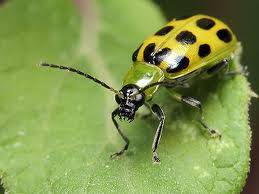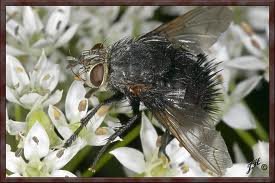Pests are on the rise at this time of season, but so is Dig It’s eradication knowledge. Here are more bad bugs and ways to get rid of them.
Cucumber Beetle


The Lowdown: Like the fabled mermaids, cucumber beetles are gorgeous in appearance, but deadly in their actions. More unfortunate is the fact that the cucumber is just one of many plants the beetle attacks. Documentation of the cuke beetle indicates it will feast on over 200 different plants in over 20 different families. Larvae will feed on the roots of plants (corn being a favorite), making them fall over. Cucumber beetles are also responsible for transmitting diseases, like bacterial wilt and the squash mosaic virus (spread primarily by the spotted and banded variety).
Biological Control: Hiring assassin bugs through plant attractants or bug hire companies is a good choice. Tachinid flies (which are attracted to Buckwheat and Parsley) use the beetle as a host for its larvae.

Beneficial Nematodes can be hired through Fifth Season, which uses the company, Nature’s Control.
Trap crops are another viable method of getting rid of the pest. Planting the trap on the borders will lead the beetles straight there and keep your precious crops undisturbed. Once infested, the grower can concentrate their insecticides in one spot. The top attractants for cuke beetles are both squash varieties: the Sunbar yellow squash and the Slender Gold yellow squash.
Human Control: Vacuuming with a small handheld at the roots and on the underside of leaves will help (and it’s sickly satisfying). Mulching early also deter the cuke beetle from laying eggs.
Insecticidal Control: A Neem Oil soak around the roots acts as an ovicide (an agent that kills eggs) and suppresses larval damage. Surround WP (which is available in-store) contains Kaolin Clay, which creates a film barrier that deters and irritates the beetle. The last resort should be a Pyrethrin-Rotenone spray.
Slugs
The Lowdown: This hermaphroditic pest rivals Mr. Fantastic for stretching properties. They can stretch over twenty times their length in order to slide through crevices in search of susceptible plants. The slime trail of the pioneer slug leaves a path for others to follow. These night feeders can decimate lettuces, brassicas, and especially hostas.
Biological Control: Comfrey leaves work as a great trap crop. Sprinkle a good amount away from the desired plant, and the slugs will crawl to them in droves. As far as plants, slugs steer clear of mint, garlic, basil, red cabbage, and even chard. Check out GHOrganics for more plant enemies. Slug predators include carabid beetles, frogs, turtles, and garter snakes.
Human Control: Beer traps work well, especially cheap light beer. Dig a hole big enough for a small container and put it flush with the ground. Add the beer and watch the party evolve. If you’re made of money, you can lay down copper strips all around the garden. The strips conduct electricity and will zap them. And, if you’re feeling sadistic, take a flashlight and a shaker of salt. Pour generously at the sight of any slug.
Insecticidal Control: Sprinkle diatomaceous earth around the base of the plant, and it will cut up the slug, making it slowly dehdyrate. Remember to add more after any rain. Another very effective product is Sluggo Plus which contain spinosad, a bacteria that attacks the nervous system once ingested.


Chris Smith says
Thank you for this clear and useful information – having major Cucumber Beetle problems at the moment and the neem oil seemed to really help just in the first spray. Fingers crossed!